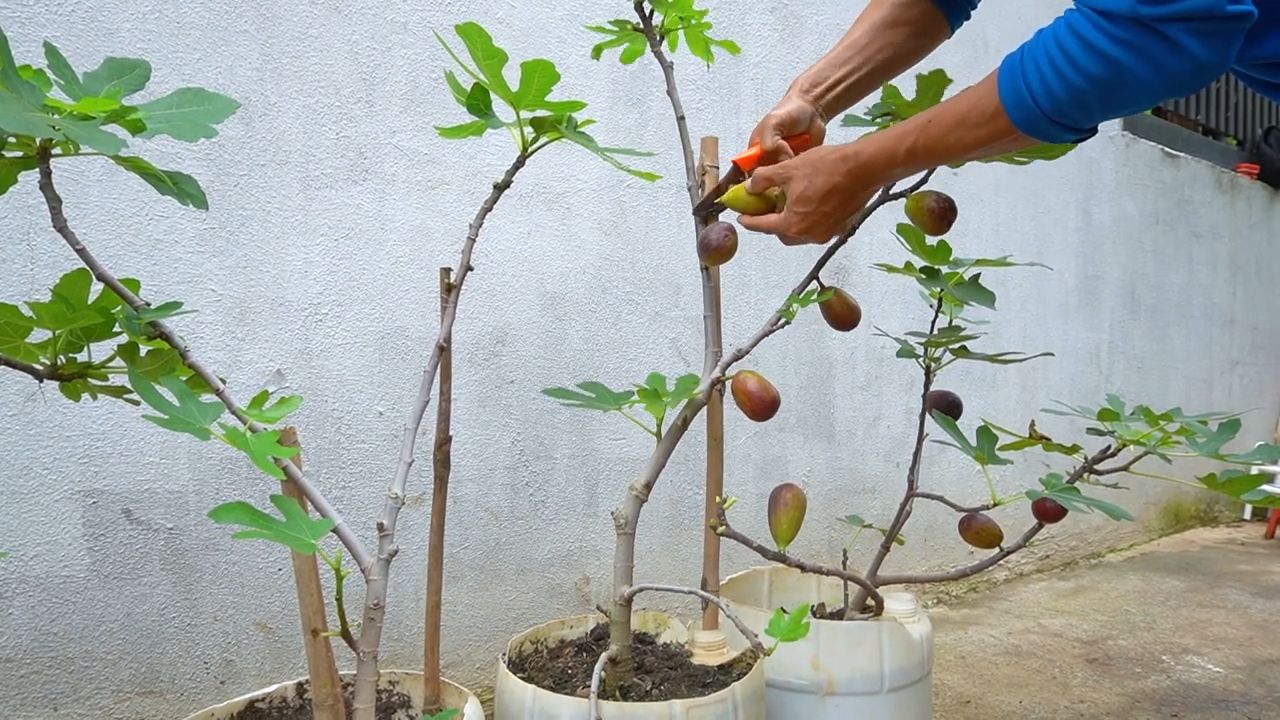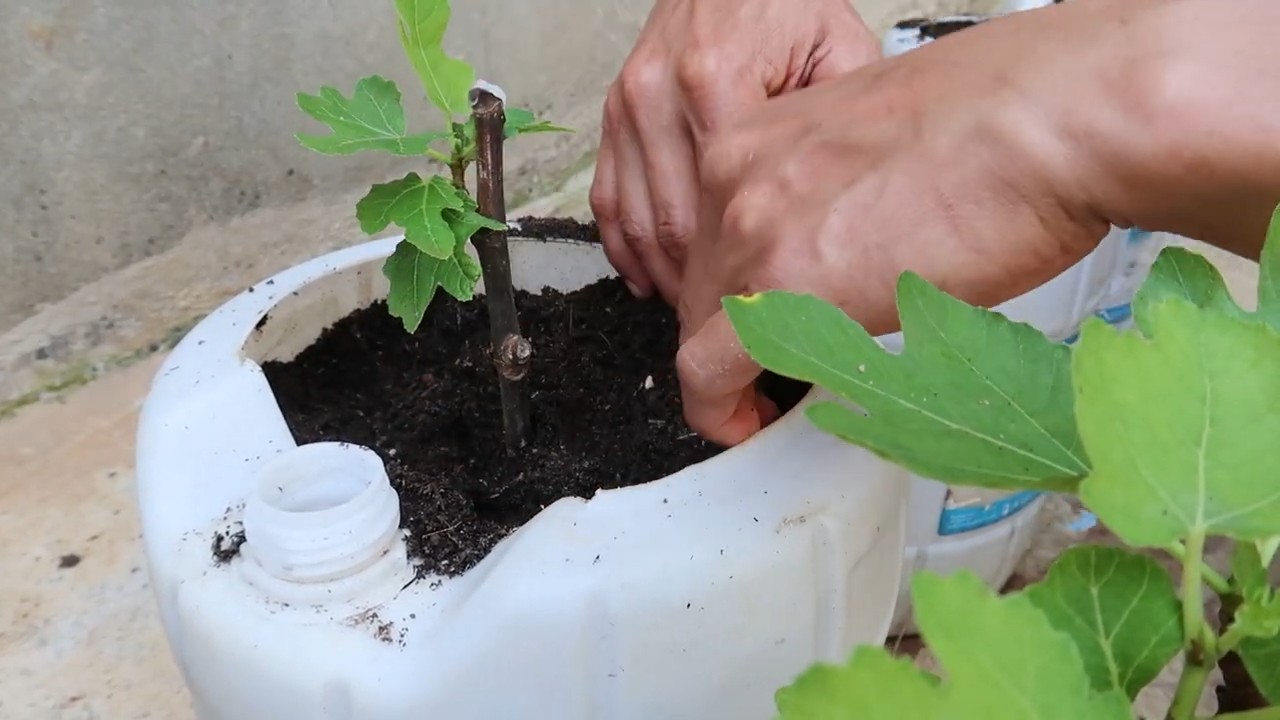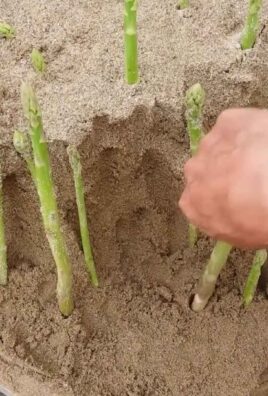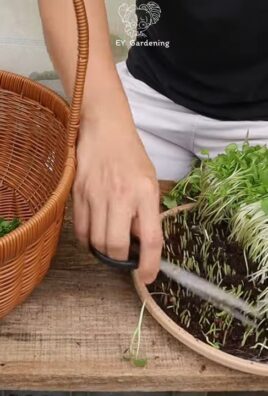Growing Figs in Containers might seem like a challenge, especially if you’re short on space or live in a cooler climate. But trust me, it’s totally achievable and incredibly rewarding! Imagine plucking sweet, juicy figs right from your patio – a taste of the Mediterranean right at your fingertips.
Figs have a rich history, dating back to ancient civilizations. They were prized by the Romans and Egyptians, and even mentioned in the Bible. For centuries, they’ve symbolized prosperity and abundance. While traditionally grown in orchards, the beauty of modern gardening is that we can adapt and enjoy these delicious fruits even in the most urban settings.
Why should you try growing figs in containers? Well, for starters, it gives you complete control over the growing environment. You can move your fig tree to the sunniest spot, protect it from harsh winter weather, and even control the soil composition. Plus, it’s a fantastic way to add a touch of elegance and greenery to your balcony, deck, or patio. Many people struggle with fig trees in the ground due to poor soil or unpredictable weather, but container gardening solves these problems. I’m going to share some simple DIY tricks and hacks that will help you successfully grow your own bountiful fig tree, no matter where you live. Get ready to enjoy fresh, homegrown figs like never before!

Growing Figs in Containers: A Step-by-Step Guide
Hey there, fellow gardening enthusiasts! I’m so excited to share my experience with growing figs in containers. It’s a fantastic way to enjoy these delicious fruits, even if you don’t have a sprawling backyard. Figs are surprisingly adaptable to container life, and with a little know-how, you can have a thriving fig tree right on your patio or balcony. Let’s dive in!
Choosing the Right Fig Variety
First things first, you need to pick the right fig variety. Not all figs are created equal, especially when it comes to container gardening. You’ll want to choose a variety that’s naturally smaller and more compact. Here are a few of my favorites:
* Brown Turkey: This is a super reliable and popular choice. It’s cold-hardy and produces delicious, medium-sized figs.
* Celeste: Another great option for cooler climates. Celeste figs are small, sweet, and have a beautiful reddish-brown skin.
* Little Miss Figgy: As the name suggests, this is a dwarf variety that’s perfect for containers. It produces abundant crops of tasty figs.
* Black Mission: If you’re looking for a rich, dark fig, Black Mission is a winner. It’s a bit more sensitive to cold, so keep that in mind if you live in a colder region.
Gathering Your Supplies
Okay, now that you’ve chosen your fig variety, let’s gather the necessary supplies. Here’s what you’ll need:
* A large container: This is crucial! Choose a container that’s at least 20-24 inches in diameter and depth. Figs need plenty of room for their roots to grow. Make sure it has drainage holes!
* High-quality potting mix: Don’t skimp on this! Use a well-draining potting mix specifically formulated for containers. Avoid using garden soil, as it can become compacted and doesn’t drain well.
* Fig tree sapling: You can purchase a fig tree sapling from a local nursery or online.
* Slow-release fertilizer: This will provide your fig tree with a steady supply of nutrients.
* Watering can or hose: For, well, watering!
* Pruning shears: For shaping and maintaining your fig tree.
* Mulch (optional): Mulch helps retain moisture and suppress weeds.
* Trowel or small shovel: For planting.
* Gardening gloves: To keep your hands clean!
Planting Your Fig Tree
Alright, let’s get our hands dirty! Here’s how to plant your fig tree in its new container home:
1. Prepare the container: Make sure your container is clean and has adequate drainage holes. If the holes are large, you might want to cover them with a piece of landscape fabric to prevent the potting mix from washing out.
2. Add potting mix: Fill the container about one-third full with your high-quality potting mix.
3. Remove the fig tree from its nursery pot: Gently loosen the roots of the fig tree. If the roots are tightly bound, you can carefully tease them apart with your fingers.
4. Position the fig tree: Place the fig tree in the center of the container, making sure the top of the root ball is level with the top of the potting mix.
5. Fill the container with potting mix: Add more potting mix around the root ball, gently firming it as you go. Leave about an inch or two of space between the top of the potting mix and the rim of the container.
6. Water thoroughly: Water the newly planted fig tree deeply until water drains out of the drainage holes. This will help settle the potting mix and ensure the roots are well-hydrated.
7. Add mulch (optional): Apply a layer of mulch around the base of the fig tree, keeping it a few inches away from the trunk. This will help retain moisture and suppress weeds.
Caring for Your Container Fig Tree
Now that your fig tree is planted, it’s time to learn how to care for it. Here’s what you need to know:
Watering
* Water deeply and regularly: Figs need consistent moisture, especially during the growing season. Water deeply whenever the top inch of soil feels dry to the touch.
* Avoid overwatering: While figs need moisture, they don’t like to sit in soggy soil. Overwatering can lead to root rot. Make sure your container has good drainage.
* Reduce watering in winter: During the dormant season (winter), reduce watering significantly. The soil should be kept slightly moist, but not wet.
Fertilizing
* Use a slow-release fertilizer: Apply a slow-release fertilizer specifically formulated for fruit trees in the spring. Follow the instructions on the fertilizer package.
* Supplement with liquid fertilizer (optional): You can supplement with a liquid fertilizer every few weeks during the growing season to give your fig tree an extra boost.
* Avoid over-fertilizing: Over-fertilizing can lead to excessive foliage growth at the expense of fruit production.
Sunlight
* Provide plenty of sunlight: Figs need at least 6-8 hours of direct sunlight per day to thrive. Place your container fig tree in a sunny location.
* Protect from intense afternoon sun (in hot climates): In very hot climates, you might need to provide some afternoon shade to protect the leaves from scorching.
Pruning
* Prune in late winter or early spring: Prune your fig tree in late winter or early spring, before new growth begins.
* Remove dead, damaged, or crossing branches: This will improve air circulation and prevent disease.
* Shape the tree: Prune to maintain a desired shape and size. You can prune to encourage branching and fruit production.
* Be careful not to over-prune: Figs produce fruit on new growth, so avoid pruning too heavily.
Overwintering
* Protect from frost: Figs are relatively cold-hardy, but they can be damaged by frost. If you live in a cold climate, you’ll need to protect your container fig tree during the winter.
* Move indoors (in very cold climates): In very cold climates, the best option is to move your container fig tree indoors to a cool, bright location. Water sparingly during the winter.
* Wrap the container (in milder climates): In milder climates, you can wrap the container with burlap or bubble wrap to insulate the roots.
* Mulch heavily: Apply a thick layer of mulch around the base of the tree to protect the roots from freezing.
Pest and Disease Control
* Inspect regularly: Regularly inspect your fig tree for signs of pests or diseases.
* Common pests: Common pests of fig trees include aphids, spider mites, and scale.
* Common diseases: Common diseases of fig trees include fig rust and leaf spot.
* Treat promptly: Treat any pests or diseases promptly with appropriate organic or chemical controls.
* Good air circulation: Ensure good air circulation around the tree to prevent fungal diseases.
Harvesting Your Figs
The moment you’ve been waiting for! Harvesting your figs is the most rewarding part of growing them.
* When to harvest: Figs are ripe when they are soft to the touch and slightly droop. The skin will also change color, depending on the variety.
* Gently pluck the figs: Gently pluck the ripe figs from the tree. They should come off easily.
* Enjoy fresh or preserve: Enjoy your fresh figs right away, or preserve them by drying, canning, or making jam.
Troubleshooting
Even with the best care, you might encounter some challenges along the way. Here are a few common problems and how to solve them:
* Fig tree not producing fruit: This could be due to a number of factors, including insufficient sunlight, over-fertilizing, or improper pruning. Make sure your fig tree is getting enough sunlight, fertilize properly, and prune correctly.
* Leaves turning yellow: Yellowing leaves can be a sign of overwatering, underwatering, or nutrient deficiency. Check the soil moisture and adjust your watering accordingly. Fertilize with a balanced fertilizer.
* Leaf drop: Leaf drop can be caused by stress, such as sudden changes in temperature or watering. Try to maintain consistent growing conditions.
* Pest infestations: Treat pest infestations promptly with appropriate organic or chemical controls.
Growing figs in containers is a rewarding experience that allows you to enjoy fresh, delicious fruit, even if you have limited space. With a little care and attention, you can have a thriving fig tree that produces abundant crops for years to come. Happy gardening!

Conclusion
So, there you have it! Growing figs in containers isn’t just a possibility; it’s a pathway to fresh, delicious figs even if you lack a sprawling orchard. We’ve explored the key steps, from selecting the right container and soil to providing the necessary sunlight and water. The beauty of this method lies in its adaptability. You can tailor the entire process to your specific climate, space constraints, and personal preferences.
Why is this DIY trick a must-try? Because it democratizes fig cultivation. No longer is the joy of harvesting your own figs limited to those with expansive gardens. Container gardening brings this experience to balconies, patios, and even sunny indoor spaces. Imagine stepping outside and plucking a perfectly ripe fig, still warm from the sun, to enjoy as a snack or incorporate into your favorite recipe. The flavor and satisfaction are simply unmatched.
But the benefits extend beyond just fresh figs. Container gardening allows you to control the growing environment more effectively. You can easily move your fig tree to protect it from harsh weather, adjust the soil composition to optimize its health, and monitor it closely for any signs of pests or diseases. This level of control translates to healthier, more productive trees and, ultimately, a more abundant harvest.
Consider these variations to personalize your fig-growing journey. Experiment with different fig varieties to discover your favorites. Some varieties, like ‘Brown Turkey’ and ‘Celeste,’ are particularly well-suited for container growing due to their compact size and cold hardiness. You can also explore different container materials, from terracotta to plastic, to find what works best for your aesthetic and budget. Don’t be afraid to get creative with your pruning techniques to shape your tree and maximize fruit production. You can even try espaliering your fig tree against a wall or fence for a unique and space-saving display.
Another exciting avenue to explore is companion planting. Certain herbs and flowers, such as basil, marigolds, and nasturtiums, can help deter pests and attract beneficial insects to your fig tree. These natural companions can contribute to a healthier and more sustainable growing environment.
Growing figs in containers offers a unique opportunity to connect with nature, cultivate your own food, and enjoy the unparalleled flavor of homegrown figs. It’s a rewarding experience that can bring joy and satisfaction to gardeners of all levels.
We wholeheartedly encourage you to give this DIY trick a try. Start small, experiment, and learn from your experiences. The journey of growing your own figs is just as rewarding as the harvest itself.
And most importantly, we want to hear about your adventures! Share your successes, challenges, and tips with us in the comments below. Let’s build a community of fig-loving container gardeners and learn from each other. What variety did you choose? What challenges did you face, and how did you overcome them? Your insights could be invaluable to other aspiring fig growers. So, grab a container, some soil, and a fig tree, and let’s get growing! We can’t wait to see what you create.
Frequently Asked Questions (FAQ)
What is the best fig variety to grow in a container?
This is a common question, and the answer depends on your climate and personal preferences. However, some varieties are generally considered more suitable for container growing due to their smaller size and cold hardiness. ‘Brown Turkey’ is a popular choice because it’s relatively compact, produces reliable crops, and is tolerant of colder temperatures. ‘Celeste’ is another excellent option, known for its sweet, flavorful figs and its ability to thrive in containers. ‘Little Miss Figgy’ is a dwarf variety specifically bred for container growing, making it an ideal choice for smaller spaces. ‘Chicago Hardy’ is known for its exceptional cold hardiness, making it a good choice for gardeners in colder climates. Research different varieties and choose one that suits your specific needs and growing conditions. Consider factors like fruit size, flavor, cold hardiness, and growth habit when making your selection.
What size container do I need for my fig tree?
The size of the container is crucial for the health and productivity of your fig tree. A young fig tree can start in a 5-gallon container, but as it grows, you’ll need to transplant it into a larger pot. A mature fig tree typically requires a container that is at least 20-25 gallons in size. The larger the container, the more room the roots have to grow, and the more stable the tree will be. Choose a container that is wide and deep enough to accommodate the root system. Make sure the container has drainage holes to prevent waterlogging, which can lead to root rot. You can use terracotta, plastic, or even repurposed containers, as long as they are the appropriate size and have adequate drainage.
What type of soil should I use for my container fig tree?
Fig trees need well-draining soil that is rich in organic matter. A good potting mix for container fig trees should consist of a blend of peat moss, perlite, and compost. Avoid using garden soil, as it can be too heavy and compact, leading to poor drainage. You can also add some slow-release fertilizer to the potting mix to provide the tree with essential nutrients. The ideal pH for fig trees is between 6.0 and 6.5. You can test the pH of your soil using a soil testing kit and adjust it accordingly. Regularly amend the soil with compost to replenish nutrients and improve drainage.
How often should I water my container fig tree?
Watering is essential for the health of your fig tree, but overwatering can be just as harmful as underwatering. Water your fig tree deeply whenever the top inch of soil feels dry to the touch. The frequency of watering will depend on the weather, the size of the container, and the type of soil. During hot, dry weather, you may need to water your tree every day. In cooler weather, you may only need to water it once or twice a week. Make sure the container has drainage holes to allow excess water to drain away. Avoid letting the tree sit in standing water, as this can lead to root rot.
How much sunlight does my container fig tree need?
Fig trees need at least 6-8 hours of direct sunlight per day to thrive. Place your container fig tree in a sunny location where it will receive plenty of sunlight. If you live in a hot climate, you may need to provide some afternoon shade to protect the tree from scorching. If you are growing your fig tree indoors, place it near a sunny window or use grow lights to supplement the natural light. Rotate the container regularly to ensure that all sides of the tree receive adequate sunlight.
How do I fertilize my container fig tree?
Fig trees need regular fertilization to produce healthy growth and abundant fruit. Fertilize your fig tree in the spring and summer with a balanced fertilizer that is specifically formulated for fruit trees. Follow the instructions on the fertilizer label for application rates. You can also use organic fertilizers, such as compost tea or fish emulsion. Avoid fertilizing your fig tree in the fall or winter, as this can encourage new growth that is susceptible to frost damage.
How do I prune my container fig tree?
Pruning is essential for maintaining the shape and productivity of your fig tree. Prune your fig tree in the late winter or early spring, before new growth begins. Remove any dead, damaged, or crossing branches. You can also prune to shape the tree and encourage branching. Fig trees produce fruit on new growth, so avoid pruning too heavily, as this can reduce fruit production.
How do I protect my container fig tree from frost?
Fig trees are susceptible to frost damage, especially when grown in containers. If you live in a climate with cold winters, you will need to protect your fig tree from frost. You can move the container to a sheltered location, such as a garage or shed. You can also wrap the container with burlap or blankets to insulate the roots. If you cannot move the container, you can wrap the tree with burlap or frost cloth to protect the branches.
How do I deal with pests and diseases on my container fig tree?
Fig trees can be susceptible to pests and diseases, such as aphids, spider mites, and fig rust. Inspect your tree regularly for signs of pests or diseases. If you find any problems, treat them promptly with appropriate insecticides or fungicides. You can also use organic pest control methods, such as neem oil or insecticidal soap. Good sanitation practices, such as removing fallen leaves and debris, can help prevent pests and diseases.





Leave a Comment